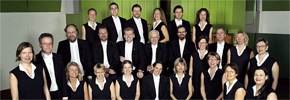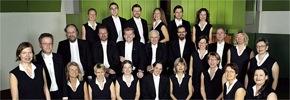
Bohlin, who has been the San Francisco Symphony’s chorus director since 2007, has substantial links to the Swedish organization. A native of Sweden, he studied conducting with Eric Ericson, who was the Swedish Radio Choir’s principal conductor for over 30 years. Bohlin, who served as choirmaster of Stockholm’s Maria Magdalena Church before coming to San Francisco, has also recorded with the Swedish Radio Choir and appeared regularly on Swedish radio with the ensemble.
Presented by Cal Performances, Sunday’s splendid concert demonstrated the conductor’s affinity for the choir and its repertoire. This was the final stop on a U.S. tour, which included appearances in Cincinnati and Chicago; if the other tour dates were as successful as the Bay Area finale, both Bohlin and the ensemble have earned new followers coast to coast.
The program, which included Swedish, German, Swiss, and American choral works, spanned centuries — sometimes in a single piece, such as the Mass for Double Chorus by Frank Martin. Based on Gregorian chant, the Swiss composer’s score is an engrossing blend of late Romanticism and early-20th-century modernism — all the while maintaining a firm foothold in the Renaissance. Martin finished it in 1923, but deemed it “unworthy” of a public hearing until the 1960s. Under Bohlin’s elegant leadership, it received a radiant performance distinguished by crisp articulation and rhythmic vivacity, particularly in the composer’s luxuriant Credo.
Just as ravishing was Mouyayoum, by Swedish composer Anders Hillborg. This is music from the opposite end of the 20th century: cool, forward-looking, unmistakably influenced by minimalism and electronica. Scored for 16-part chorus, it begins with a subdued drone suggesting a large engine idling at a distance; gradually, individual voices emerge, intoning wordless texts: tightly coiled parts for the men, and short, insistent ululations for the women. The sounds merge in a glassy wall of sound, then recede. Sunday’s program booklet described it as “cosmic trance” music, and the singers performed with such precision that it was indeed mesmerizing.
Serene, Silvery Sonic Snowfall
Hillborg’s compact masterpiece wasn’t the only Swedish work on the program. The first half opened with Hugo Alfven’s Aftonen (Evenings), a serene setting of a text by Herman Satherberg. Here, the crystalline sound projected by the women of the choir suggested the hushed purity of a recent snowfall.Sven-David Sandstrom, one of Sweden’s top contemporary composers, was represented by Lobet den Herrn. Incorporating the text used in a Bach motet of the same name, Sandstrom writes in a pointillist onslaught of sound, which the choir delivered with chilly fervor.
Bohlin, who is a graceful, sensitive podium presence — less a sculptor than a sublime watercolorist — made an intriguing segue from Sandstrom to Bach’s motet Singet dem Herrn ein neues Lied, eliciting a wealth of color and texture from the choir’s immaculate vocal blend. The central aria, “Wie sich ein Vater erbarmet” (As doth a father mercy show), was especially arresting.
In between came Ned Rorem’s In Time of Pestilence, which sets texts by 16th-century poet Thomas Nashe. Incisive and harrowing, the 1973 work seems to anticipate the era of the AIDS epidemic; each verse ends with the cry “I am sick, I must die, Lord have mercy on us!” The singers, negotiating Rorem’s angular leaps and laments, put the music across in clear, austere bursts of sound.
“Ich bin der Welt abhanden gekommen,” Mahler’s endlessly touching song of farewell from the Ruckert lieder, followed. Originally composed for orchestra and mezzo-soprano soloist, it has become a choral favorite in Clytus Gottwald’s arrangement for 16-part choir. To my ears, Gottwald’s version loses some of the original’s aching sense of intimacy. Yet it retains the wonted tone of otherworldly resignation. Under Bohlin’s direction, it flowed seamlessly.
Bohlin and the choir returned for two encores: Alfven’s brisk Och jungfrun hon gar i ringen and Wilhelm Stenhammar’s softly floated Tre Korviso.

